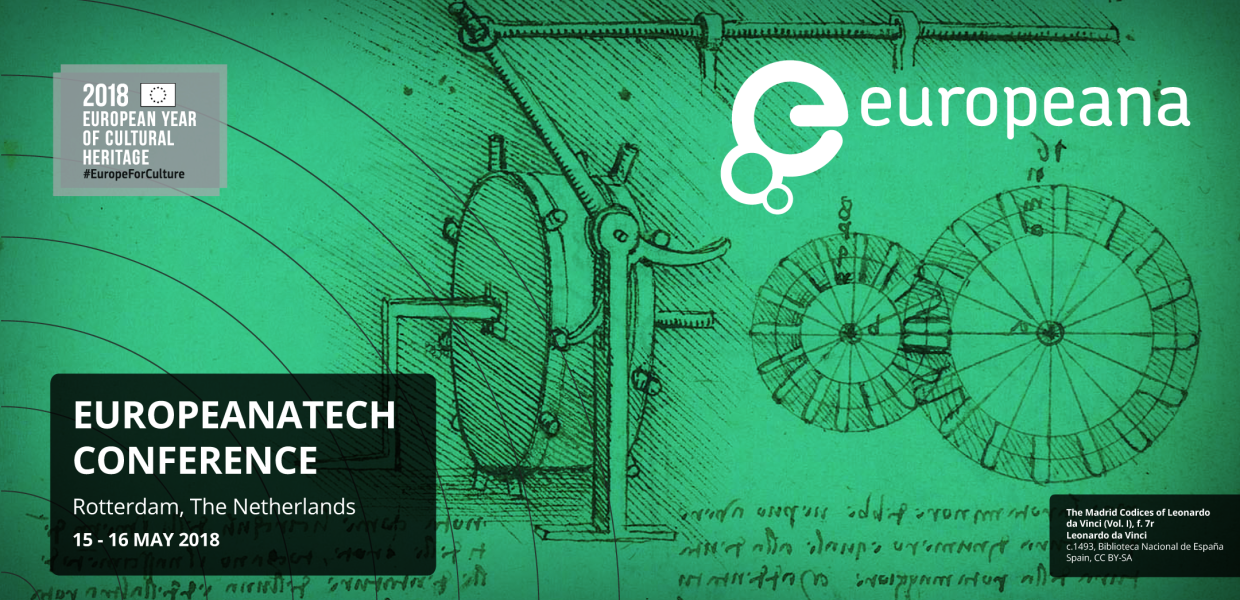EuropeanaTech 2018 - Our keynote speakers - part one
EuropeanaTech 2018 is a little over six weeks away. Joining the 300+ innovators and thought-leaders in tech in the cultural heritage sector are six keynote speakers from around the world. We are very excited to be introducing them, and their keynote presentations, over the next few weeks.

- Title:
- The Madrid Codices of Leonardo Da Vinci (Vol. I), f. 7r
- Creator:
- Leonardo Da Vinci
- Date:
- c.1493
- Institution:
- Biblioteca Nacional de España
- Country:
- Spain
- Copyright:
- CC BY-SA
About EuropeanaTech 2018
EuropeanaTech 2018 will place tech firmly at the centre of the European Year of Cultural Heritage and will bring together an international network of technical and R&D specialists from cultural heritage organisations, research institutions and creative industries. Leading specialists, practitioners and researchers from across the world will converge in Rotterdam in May 2018 to share innovative progress and forecast the technical future of digital cultural heritage.
The conference will cover the three - Ds, Data, Discovery and Delivery - and we are delighted with the array of experts we have to lead us through these areas. No less so than our keynote speakers, who have been cherry-picked from different industries ranging from research to heritage, and who are recognised as world-leaders in their fields.
Book your place
Alongside our keynote speakers we have a very exciting line-up of speakers and panel members who are leading the way in tech, and there are even two free events on the day before the conference starts. View the programme and get your ticket now for the bargain price of €185.
Meet our keynote speakers:
Herbert Van de Sompel, Information Scientist, Los Alamos National Laboratory, United States
Herbert Van De Sompel is the most recent recipient of the Paul Evan Peters Award - awarded for a ground-breaking and lasting contribution to the creation and innovative use of network-based information resources and services that promote intellectual productivity and scholarship. Herbert was the first recipient of the SPARC Innovator Award by the Scholarly Publishing and Academic Resources Coalition (SPARC) for starting the Open Archives Initiative (OAI) and the open reference linking framework (OpenURL). We are delighted he is flying over to Europe to present the conference ‘Future Note’ on Tuesday 15 May, titled ‘The Weak Link’.
Links are a powerful and essential component of the web but also its Achilles heel. We are all familiar with Link Rot - links stop working - but less so with Content Drift - the content at the end of links changes over time. While both Link Rot and Content Drift are generally a nuisance, they are unacceptable when links from managed collections, such as cultural heritage and scholarly communication, are concerned because they undermine the integrity of the collections. During the presentation, a wide range of technologies and approaches will be featured, including Persistent Identifiers, Robust Links, Link Decoration, Memento, Web Archives, and Linked Data Archives.
Herbert says: 'For 20 years, I have been focusing on leveraging the web for scholarly communication. There is a lot moving in that space but the neat stuff occurs and remains at the fringes, isn't able to go mainstream. I have witnessed a rather different dynamic when it comes to cultural heritage where some very significant technical innovations are becoming widely adopted. That is leading to significant levels of interoperability between collections and it brings us closer to a bright future with advanced cross-collection services. For anyone interested in learning where this is all heading, EuropeanaTech2018 should really be a blast.'
Emilie Gordenker, Director, Mauritshuis, the Netherlands
Emilie Gordenker has been Director of the Royal Picture Gallery Mauritshuis in The Hague for the last ten years. An art historian, lecturer and curator, Emilie is presenting our closing keynote on Wednesday 16 May, titled ‘Dutch Old Masters and New Technologies’.
The Mauritshuis has a compact collection of 850 Old Master paintings, with a strong concentration of paintings of the Dutch Golden Age. The focus and quality of the museum's holdings - plus the setting in a 17th-century building - make the Mauritshuis unique. But this also presents a challenge: how do they make the narrow range of Old Master paintings come alive to a younger audience? In this lecture, Emilie will discuss recent initiatives that harness new technologies to attract a broad audience, from specialists to first-time visitors.
If you are interested in sponsoring the event, we have a range of options available.

